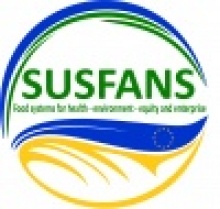Workshop report: 4 th Stakeholder Core Group Workshop
The Workshop aimed to inspire the consumer oriented way of thinking facilitated by a stepwise approach and introducing the consumer drivers of food and dietary choice into prospective studies on the sustainability of the EU food system. The Workshop also evaluated and prioritized the consumer-oriented innovation pathways on fruit and vegetables in the EU and the project also wanted to receive feedback on the on going foresight work of SUSFANS. Furthermore, the Workshop also aimed to discuss the likely key outputs of the project and how these could be of use to the stakeholders and their organizations. Finally, the project team wanted to discuss with stakeholders how to deliver the outreach work of the project beyond the stakeholder core group itself asking the group to help shaping the key messages of the project to the different stakeholder communities and discussing how the group could play an ambassadorial role for the project.
Take a look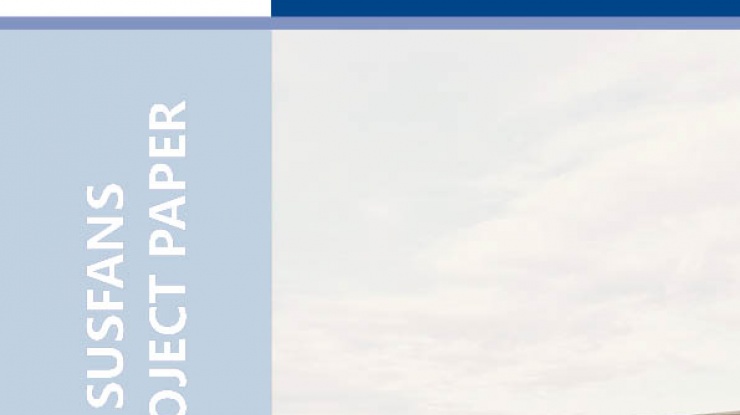
The vision of the SUSFANS project
This paper defines the research agenda of the SUSFANS project. It aims to contribute to balanced and encompassing views on how to strengthen food and nutrition security outcomes in the EU and how to improve the performance of the food system in the EU from the perspective of social, environmental and economic sustainability. The research is led by the notion that improvements in the diets of the European consumer must come from, and be supportive of, sustainable food systems. Its holistic, integrative approach builds a set of metrics, models and foresight tools, useable for navigation on sustainable food and nutrition security. It thereby results in a coherent and supported vision on what entails sustainable food and nutrition security in the EU and globally, and underpins a perspective on how EU policies on farming, fishing, food and nutrition could contribute to that vision with greater efficacy than today.
Take a look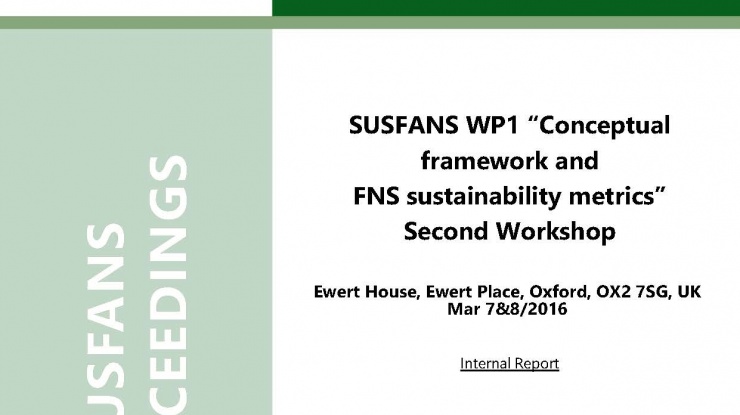
SUSFANS WP1 “Conceptual framework and FNS sustainability metrics” Second Workshop
Ewert House, Ewert Place, Oxford, OX2 7SG, UK Mar 7-8/2016 Overall chair: John Ingram (UOXF) Rapporteur: Monika Zurek (UOXF), John Ingram (UOXF), Joost Vervoort (UOF) The first part of the afternoon of Mar 7th was used to update meeting participants on the progress of the project since its beginning. After a welcome by John Ingram and a round of introductions, project coordinator Thom Achterbosch gave a presentation on project activities over the first year of the project and on the schedule of deliverables over the next year. These include two deliverables for WP1, namely a paper on the SUSFANS conceptual framework (D1.1) and on the metrics for assessing sustainable FNS (D1.2 and D1.3). Particularly the work on finalizing the metrics was the focus of this workshop.
Take a look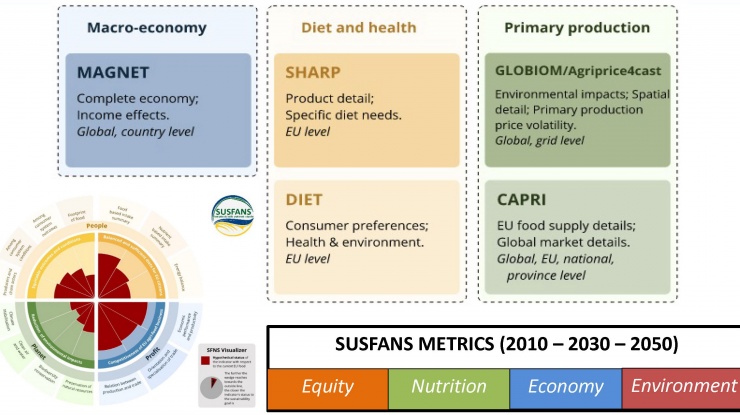
SUSFANS Toolbox
SUSFANS presents a novel approach to deliver quantitative foresight on diet change, policy and production system innovations, and assess the potential impact on the sustainability performance of the EU food system: • Include EU-specific nutrition surveillance data (i.e. individual food intake) in a framework for integrated multi-criteria assessment of the EU and global food system, benchmarking national data against a reference sustainable, healthy diet for EU. • Modelling the entire system, including post-harvest food handling & retail, global trade, natural resource use, food loss and waste, and impacts on diets, environment, economy and equity. • Exploring instruments and transformative pathways incl. economic sustainability and equity. • The SUSFANS modelling toolbox comprises of five models: MAGNET (developed by Wageningen Economic Research), SHARP diets (developed by Wageningen University and partners), DIET (developed by Luke and INRA), GLOBIOM & AgriPrice4Cast (developed by IIASA) and CAPRI (developed by Bonn University and EC’s Joint Research Centre). See diagram.
Take a look
State of play in the SUSFANS project - second period
SUSFANS focuses on a number of core questions: How can we improve the food system of the EU, especially from the perspective of social, environmental and economic sustainability? How can we balance and encompass different views on balanced consumer diets and food and nutrition security in the EU? The research approach is built around the development of a set of metrics, models and foresight tools, which can be used to navigate through decisions on measures for achieving sustainable food and nutrition security. This approach results in a holistic, integrated and coherent vision of what entails sustainable food and nutrition security in the EU in a context of global change. It underpins a perspective on how EU policies on farming, fishing, food and nutrition could contribute to that vision with greater efficacy than today.
Take a look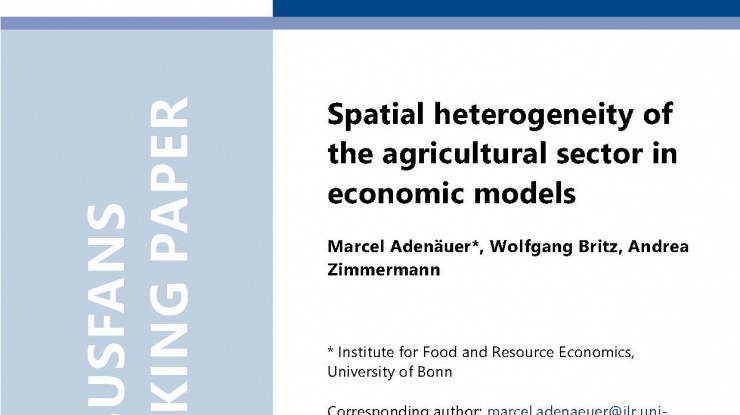
Spatial heterogeneity of the agricultural sector in economic models
Recent food price spikes and their potential link to biofuel and increased food demand (e.g. Ajanovic, 2011; Gilbert, 2010; Mueller et al., 2011; Piesse and Thirtle, 2009; Zilberman et al., 2012), on-going land use changes, such as conversion of tropical forest to agricultural land, and their relation to Green House Gas Emissions (cf. Harvey and Pilgrim, 2011) and discussions around the so-called bioeconomy (e.g. Hertel et al., 2013; Sheppard et al., 2011; Zilberman et al., 2013) all have renewed societal and scientific interest in better understanding how agricultural land use reacts to price and policy signals. Consequently, economic models working on quite different scales and being based on different methodologies were extended in recent years to better deal with land use and management issues.
Take a look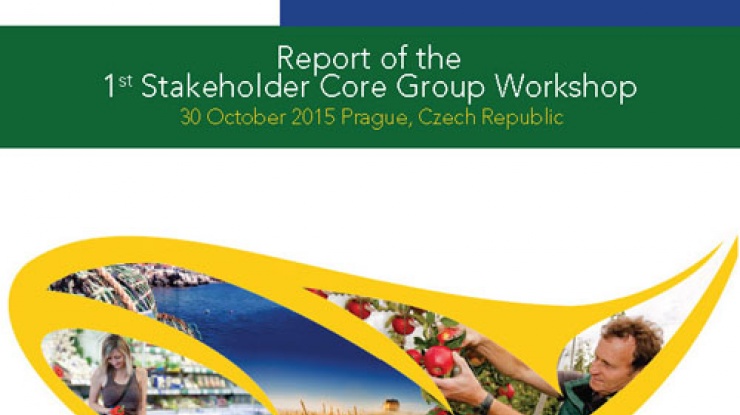
Report of the 1st Stakeholder Core Group Workshop
Report of the 1st Stakeholder Core Group Workshop with a summary of the Workshop and Stakeholder Recommendations. The first SUSFANS stakeholder workshop brought 42 participants together of which roughly 60% were representatives of different stakeholder groups and the rest researchers from the various research teams involved in the project. The stakeholder group was constituted of about a quarter of food system actors, such as primary producer and the food processing industry. The largest group of stakeholders present were so-called food system influencers such as civil society organization and advocacy groups working on food issues. In addition, a small number of EU policy makers (DG Research, DG Agri) joined the workshop.
Take a look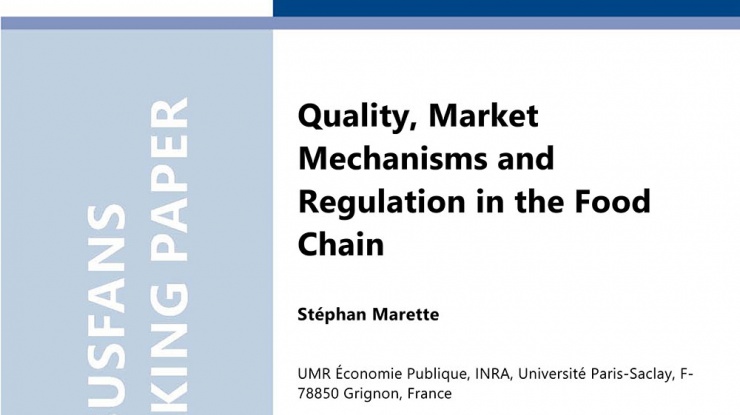
Quality, market mechanisms and regulation in the food chain
This paper focuses on questions related to the regulation of quality in the food chain. The paper first recalls the new challenges related to quality in the food chain, with an emphasis on the issue of sustainability. This first part underlines that the numerous dimensions related to sustainability make the regulation necessary but difficult. Then the paper introduces a partial equilibrium model calibrated with empirical data, for helping evaluate which regulatory instrument should be socially preferred ex ante on a case-by-case basis. An application to the milk market focuses on linseed for feeding dairy cows, which reduces methane emissions and increases the omega-3 content of milk. Simulations compare the impact of the exclusive use of one label signaling omega-3, versus the impact of a minimum-quality standard imposing linseed in the diet of all dairy cows. Both instruments would have a positive impact on consumers' surpluses and some producers’ profits. This application shows that details about the influence of regulatory tools on surpluses may be given on a case-by-case basis. Download as SUSFANS paper: http://susfans.eu/system/files/public_files/Publications/working_paper/Marette-Quality_Market_Mechanisms_and_Regulation_in_the_Food_Chain.pdf
Take a look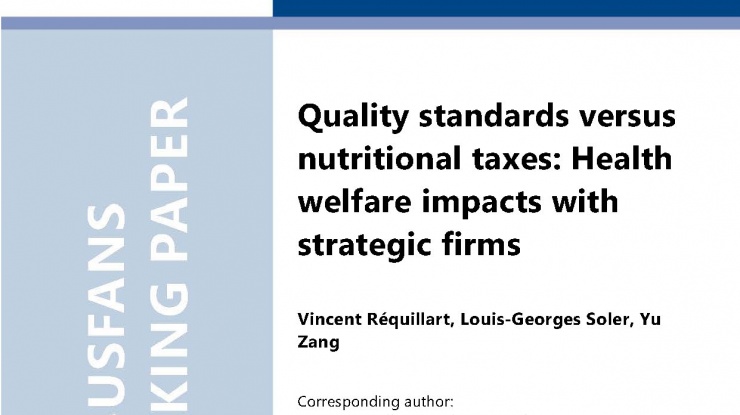
Quality standards versus nutritional taxes: Health welfare impacts with strategic firms
The goal of this paper is to better understand firms' strategic reactions to nutritional policies targeting food quality improvements and to derive optimal policies. We propose a model of product differentiation, taking into account the taste and health characteristics of products. We study how two firms react to alternative policies: an MQS policy, linear taxation of the two goods on the market, and taxation of the lowquality good. The MQS and the taxation of the low-quality product are the preferred options by a social planner. If taste is moderately important, the MQS policy is chosen by a populist and a paternalist social planner. If taste is a major component of choice, the populist planner chooses to tax the low-quality product whereas the paternalist planner prefers the MQS policy. Finally, for a paternalist social planner, an MQS-based policy always allows for higher levels of welfare than an information policy alone.
Take a lookOperationalising the health aspects of sustainable diets: a review
Shifting towards a more sustainable food consumption pattern is an important strategy to mitigate climate change. In the past decade, various studies have optimised environmentally sustainable diets using different methodological approaches. The aim of the present review was to categorise and summarise the different approaches to operationalise the health aspects of environmentally sustainable diets.
Take a lookNewsletter 5
SUSFANS is entering the final phase of the project, the development of (an interactive demo of) the SUSFANS Visualizer as a web-tool has been initiated. It is planned to populate the tool with scenario results from the foresight report, and that we allow users to explore trade-offs between sustainability challenges and possible impact of policy changes or systems innovations. The resulting and already famous toolbox will be presented and discussed on a tour through Europe starting soon. Read more in this newsletter!
Take a lookNewsletter 4
The fourth Newsletter includes a preview of the forthcoming Stakeholder Core Group workshop in June 2017. Furthermore, features of the latest three deliverables which have been published.
Take a lookNewsletter 3
The third newsletter covers the progress of the project. One major achievement is that SUSFANS has entered into a partnership with FIT4FOOD2030, a new project for building the platform for dialogue on the FOOD2030 agenda of the EU. The newsletter includes a short summary of the year 2017 and research insights.
Take a lookNewsletter 2
The second newsletter answers research questions like: "What do European consumers think about sustainable food?", "Can information beef up the demand for meat alternatives?" or "Can we bank on seafood for a healthier food consumption?" It gives short summaries of the deliverables and papers, published during the last month
Take a lookNewsletter 1
The first Newsletter of 2016 on project updates and informative SUSFANS research
Take a lookEnhanced modelling of sustainable food and nutrition security: the agri-food commodity and nutrient flows and the food supply chains
This deliverable describes the enhanced modelling of agri-food commodity and nutrient flows and representation of the food supply chains and markets in economic models.
Take a lookDeliverable 9.6: The strengths and limitations of the SUSFANS metrics and models for assessing sustainable food and nutrition security in Europe
The SUSFANS model toolbox comprises state-of-the-art foresight and newly developed diet models for a holistic sustainability and dietary assessment. The toolbox is ready to assess the food system transitions to support healthy and sustainable diets of EU citizens. A future research agenda for the modelling of food system properties is proposed regarding modelling of food supply, consumer choices, global impacts and for assessing and communicating complex model results.
Take a lookDeliverable 9.5 The SUSFANS toolbox for assessing EU Sustainable food and nutrition security
The SUSFANS toolbox for assessing EU sustainable food and nutrition security provides a multidisciplinary instrument for analysing and monitoring SFNS in the EU, providing a set of mutually consistent indicators and signals for (un)sustainable food (in)secure situations.
Take a lookDeliverable 9.3: Enhanced modelling of sustainable food and nutrition security: food supply and use of scarce resources
This deliverable reports on Task 9.3 and describes the enhanced modelling of food supply and the use of scarce resources. The enhancements improve the analysis of sustainable food and nutrition security in response to (policy) shocks with regard to coverage and accuracy of sustainability metrics provided by long-run modelling tools in SUSFANS.
Take a lookDeliverable 9.2: Enhanced modelling of sustainable food and nutrition security: food consumption and nutrition behaviour of European households
This deliverable describes the enhanced modelling of food consumption and nutrition behaviour under constraints with a focus on European households and population health impacts of changes in diets. The demand side enhancements enable the analysis of SFNS over time and in response to (policy) shocks.
Take a look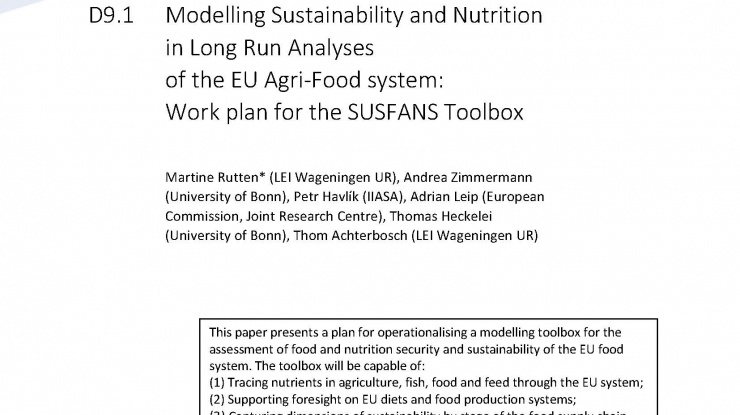
Deliverable 9.1: Modelling Sustainability and Nutrition in Long Run Analyses of the EU Agri-Food system: Work plan for the SUSFANS Toolbox
This paper presents a plan for operationalising a modelling toolbox for the assessment of food and nutrition security and sustainability of the EU food system. The toolbox will be capable of: (1) Tracing nutrients in agriculture, fish, food and feed through the EU system; (2) Supporting foresight on EU diets and food production systems; (3) Capturing dimensions of sustainability by stage of the food supply chain (primary food production, food processing and consuming); (4) Providing entry points for policy and innovation by government, private sector, NGOs and the science community.
Take a lookDeliverable 8.4: Early warning systems for commodity markets
An agricultural commodity price and price volatility forecasting modelling system has been developed and applied for four agricultural commodities to perform forecasts on a horizon spanning from three months to one year. The forecasting system can be used as an early warning system based on seasonal and decadal simulated weather and climate forecasts in combination with financial and macro-economic projections.
Take a lookDeliverable 8.3: Forecasting Commodity Prices Under Specification Uncertainty: A Comprehensive Approach
We present a comprehensive modelling framework aimed at obtaining short-term forecasts (one to twelve months ahead) of commodity prices and apply it to short and medium run predictions of Arabica coffee, wheat, soybeans and corn. We entertain a large number of univariate and multivariate time series models, including specifications that exploit information about market fundamentals, macroeconomic and financial developments and climatic variables. A comprehensive set of forecast averaging tools is implemented to explicitly address model uncertainty. Our results indicate that variables measuring market fundamentals and macroeconomic developments (and to a lesser extent, financial developments) contain systematic predictive information for out-of-sample forecasting of commodity prices.
Take a lookDeliverable 8.2: Preliminary report on Task 8.2: prices forecasting model
We present a comprehensive modelling framework aimed at obtaining shortterm forecasts of commodity prices. The publication has been released to the consortium members
Take a lookDeliverable 8.1: The decomposition of agricultural commodity markets volatility between fundamentals and market speculation
We analyse the role played by market fundamentals, speculation and macroeconomic conditions as empirical determinants of commodity price changes. We combine model averaging techniques to explain historical patterns with an in-depth analysis of out-ofsample predictability of commodity prices using fundamentals as well as macroeconomic and financial variables. Our results indicate that variables related to global macroeconomic and financial developments contain valuable information to explain the historical pattern of coffee price developments, as well as to improve out-of-sample predictions of coffee prices.
Take a lookDeliverable 7.5: The SHARP diet model and its application to different EU regions Working document including preliminary results
-This deliverable has not yet been published - The SHARP diet model makes use of individual-level dietary intake data of different EU countries to derive diets that are more environmentally Sustainable, Healthy, Affordable, Reliable, and Preferred by consumers. Options for dietary change are derived from existing efficient diets, hence within the boundaries of current dietary practices and realistic. The SHARP diet model proposes future EU diets that are both healthy and sustainable, and likely to be accepted by consumers #SHARP #die
Take a look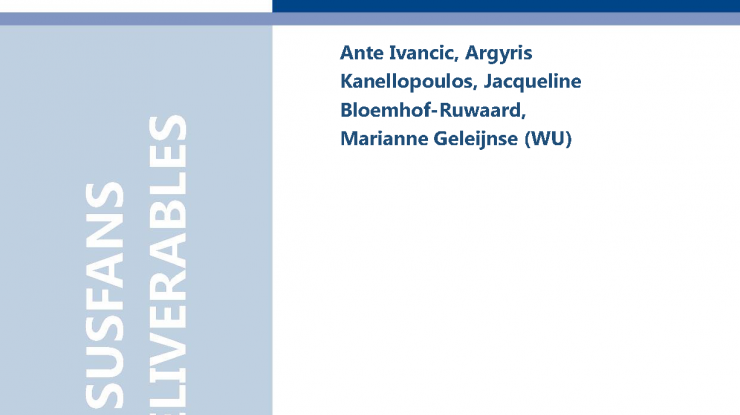
Deliverable 7.4: Toward modelling SHARP diets, based on nutritional adequacy, sustainability metrics and population diversity parameters
Diet modelling has been dominated by linear programming models for many years, however their success has been limited, while their inability to extract value from data in our information-driven world has become readily apparent. Increasing consumers’ diet healthiness has been the primary task of almost all diet models, however to actually change patterns of consumers’ purchasing behavior, models have to learn their preferences, so as to recommend diet alternatives that are both healthy, and appealing. We present our data-driven approach that leverages food item similarities as the main building blocks of diet recommendations, which arguably represents a paradigm shift in the way we optimize diets. Furthermore, we switch from exploiting what is known to be preferable (i.e. what we observe in a consumer’s diet), to exploring what is likely preferable, thereby allowing our diet model to “think outside the box”.
Take a lookDeliverable 7.3: Initial model for designing SHARP diets
Designing healthier diets is a complex process which can have substantial public health benefits.The intakes, but also the requirements of multiple important nutrients for different population groups should be taken into account. Moreover, the current dietary preferences of individuals should be considered to promote the acceptability of the diet. Diet models have been developed and used for designing suchhealthier and acceptable diets. The main objective of these models is to determine the optimal quantities of available food items that should be included in a diet to optimize a specific indicator (e.g. maximize a dietary quality index). Additional constraints are defined to improve the acceptability of the calculated diets. These constraints are either in the form of upper and lower limits to the intake of specific food-items or in the form of fixed combinations of food-items in meals. Defining such constraints explicitly is challenging and involves expert knowledge and a substantial degree of arbitrariness. To avoid defining such acceptability constraints we propose a DEA based diet model that benchmarks existing complete diets of a certain population and in our case identifies healthier alternatives. However, the model's flexibility allows for additional dimensions to be included, such as sustainability indicators and prices. The method was applied successfully to benchmark alternative diets of a group of individuals in the Netherlands.
Take a lookDeliverable 7.1: The initial model to design SHARP diets, based on nutritional adequacy and preliminary sustainability metrics
This paper collates food and nutrient intake data from Denmark, Czech Republic, Italy and France. Nutritional adequacy of the diets will be assessed using a protocol developed in WP2. This is the basis for the initial model to design SHARP diets, based on nutritional adequacy and preliminary sustainability metrics.
Take a lookDeliverable 6.3: A systematic analysis of social, economic and environmental sustainability metrics for the range of activities and world views encompassed in the EU food systems
Paper not yet released - SUSFANS proposes a multi-layered index of sustainability metrics for the assessment of the EU food system, food security and dietary habits. Based on a stakeholder-informed scientific attempt to create better insight in and to unveil the complexity of food systems, this report presents one of the core joint results of the SUSFANS research & innovation project. A simple and non-academic interpretation of the highest level of information in the index is provided below.
Take a lookDeliverable 6.2: A systematic review of existing EU-wide scenarios related to the EU sustainable food and nutrition security, identification of most salient features, and resulting synthesis scenarios for exploring sustainable diets
Scenarios as a tool to reflect on future pathways to sustainable food and nutrition security. Building on existing foresight and scenario exercises and identifying their most salient features in order to be combined in SUSFANS scenarios able to assess the EU policy goals for food systems.
Take a lookDeliverable 6.1: The SUSFANS Stakeholder Core Group, drawn across different sectors and roles in European FNS
Establishing a Stakeholder Core Group (SCG). A SCG of about 40 organisations will be convened, drawn from suggestions from all SUSFANS WP leaders. Balance across stakeholder communities, food systems areas, countries and gender will be paramount. This SCG will spearhead the stakeholder interaction across WPs 1-5, with WP11, and with other WPs as appropriate. Other members will therefore be co-opted as needed.
Take a lookDeliverable 5.4: Sustainability impacts of potential innovations in the supply chain of livestock and fish, and fruit and vegetables, and sustainable future diets (Report on T5.4)
To assess different possible future directions for the EU food system, potential innovations were identified towards achieving sustainable healthy diets within the EU. The innovations focused on two cases, the ‘livestock and fish case’ and the ‘fruit and vegetable case’. For both supply chains there are concerns regarding the current European diet (excessive consumption of livestock and too low consumption of fruit, vegetables and seafood). For animal production, i.e. livestock and seafood, environmental concerns (land use, GHG emissions, fish stock depletion etc.) are particularly pressing.
Take a lookDeliverable 5.3: Innovation pathways towards more sustainable production and consumption in the fruit - vegetable supply chain and their uptake in the SUSFANS models
Fruit and vegetable consumption is below recommended levels and should increase to come closer to a more healthy and sustainable diet in Europe. The aim of this report is to identify innovation pathways in the fruit and vegetable chain from a consumer perspective. The deliverable shows the different elements of a consumer perspective, their relevance and above all the need to combine consumer, production and circular perspectives on innovation to support fruit and vegetables consumption. To understand or even stimulate consumption behaviour a wide array of drivers need to be taken into consideration, which relate to the individual (biological, demographics, psychological), the product, the interpersonal, physical environment and policy. These are represented in consumption-related innovations such as: targeting, motivating, contextual, communicating and acceptance of innovations; product related innovation such as: product, production, and package; and circular innovations (in particular around reducing food waste). This paper is meant to inspire, raise awareness, and continue the discussion on a strengthened consumer perspective in the innovation strategies, foresight and modelling work in SUSFANS.
Take a lookDeliverable 5.2: Innovation pathways towards future nutrition security: Innovation pathways towards more sustainable production and consumption in the livestock-fish supply chain and their uptake in the SUSFANS models
Our current dietary pattern especially animal source food (ASF), has a strong impact on the environment. Furthermore, in Europe, daily consumption of ASF protein is above dietary recommendation, resulting in an increased risk of chronic non-communicable diseases.The aim of this deliverable was to identify innovations that together can result in a pathway towards sustainable nutrition security by combining production-side strategies (reducing the environmental impact per kg of ASF produced), consumption-side strategies (changing consumption patterns of humans by reducing or replacing ASF), and the circular strategie, (focus on improving the circularity of the food system, and avoiding feed-food competition, and lies in between the production and consumption-side strategies). The paper identifies a set of innovations that has the potential to deliver a pathway towards sustainble healthy diets. These innovations comprise: including insects in livestock and fish feed; reducing meat intake and replacing beef with other ASF products including fish, and including novel protein source e.g. in-vitro meat; a circular strategy centred around using products unfit for human consumption in livestock feed. Data is presented that supports the assessment of the impact of these innovation options on the contribution of ASF in a sustainable and healthy diet, using the SUSFANS toolbox. Similar to this the role of captured seafood - fishing at equilibrium (sustainable yields)- in a suitable diet will be assessed.
Take a lookDeliverable 5.1: Baseline sustainability assessment of the current state of livestock/fish and fruit/vegetables supply chains
To assess different possible future directions for the EU food system, potential pathways based on a set of innovations need to be identified. The aim of WP5 is to define different pathways towards more sustainable and healthy diets within the EU, without negative implications in the rest of world. This first report of WP 5 makes the case for the two selected case studies based on the current situation, provides as first set of innovation pathways and explores the use of metrics in a spider diagram to assess sustainable FNS. The innovations focus on two cases, ‘livestock and fish case’ and ‘the fruit and vegetable case’. For both supply chains there are concerns regarding the current European diet (too high consumption of livestock and too limited consumption fruit, vegetables and seafood), whereas for livestock and fish production there are also pressing environmental concerns (land use, GHG emissions, fish stock depletion).
Take a look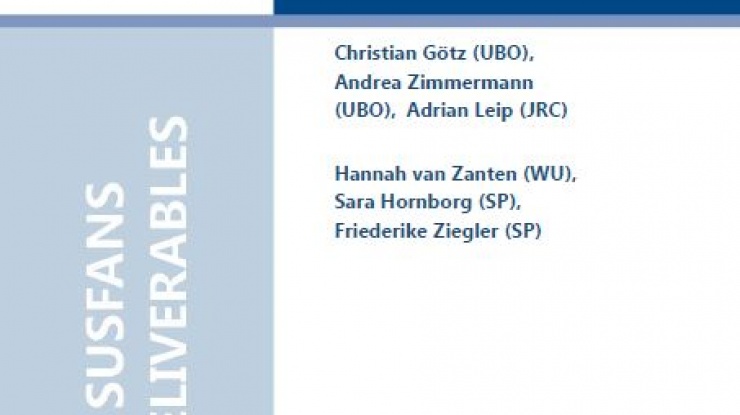
Deliverable 4.7: Database on farm-level production and sustainability indices for assessing sustainable diets
This paper demonstrates that SUSFANS metrics for assessing the environmental sustainability of the European food system can be effectively produced and applied to assess policy measures and potential innovations that aim at achieving sustainable food and nutrition security in the European Union. The analysis points at important issues that need to be taken into account for the further development and application of metrics.
Take a lookDeliverable 4.6: Spatially explicit farm and environmental indicators at a scale of 1 km x 1 km
Land use diversity and soil erosion are amongst the aggregated variables required for describing environmental sustainability in the domains ‘biodiversity’ and ‘natural resources’. Both aggregated variables need to be quantified at high spatial resolution. The CAPRI model is able to do this, but the calculation procedure required improvements. This report describes basic features of the methodology, scrutinizes deficiencies in the current implementation and identifies possibilities to update and improve the method.
Take a lookDeliverable 4.5: The drivers of crop production at regional level in the EU: an econometric analysis
Crop production is the most crucial primary agricultural production activity for both food and nutrition security. Around 70% of the calories per capita and day come from plant-based products. The report provides a qualitative assessment of drivers of crop production and a quantitative analysis of crop yields in the EU. Crop yield trends are largely positive throughout the EU. Average efficiencies in yield exploitation are between 70 and 80% depending on the crop. Climate has mixed effects on crop yields and farm size, fertilizer and plant protection all clearly positively affect crop yields.
Take a lookDeliverable 4.4: Preliminary report on Task 4.4: drivers of crop production
Crop production is the most crucial primary agricultural production activity for both food and nutrition security. Around 70% of the calories per capita and day come from plant-based products. Besides its importance for direct human consumption, crop production is also crucial for producing feed for livestock and aquaculture. The report provides a qualitative assessment of drivers of crop production and preliminary work for a quantitative analysis of crop production in the EU.
Take a lookDeliverable 4.3: Establishing a common accounting system for the LCA and emission leakage in the CAPRI model
The CAPRI model can be used in order to estimate GHG emissions from the agricultural sector in the EU. However, the calculation follows the logic of the UNFCCC framework, assigning emissions to production activities and the regions where those activities take place. In order to move from a production towards a more consumption oriented perspective we developed an LCA-module (Life cycle Assessment), both for EU and Non-EU regions, covering not only regional emissions but also emission leakage and worldwide emissions.
Take a lookDeliverable 4.2: The drivers of fisheries and aquaculture production in the EU
The role of seafood is complex in sustainable and nutritious diets. Production from c apture fisheries is limited whereas s eafood from aquaculture is seen as the most promising food production systems for the future. In this report, data on EU seafood production is provided, as well as a review of indirect and direct drivers for seafood produc tion in the EU. Several plausible directions for improved sustainability of seafood productio n in EU FNS are identified. Furthermore, metrics for environmental assessment of seafood in relation to EU policies on reduced environmental impacts are suggested .
Take a lookDeliverable 4.1: The drivers of livestock production in the EU
In the last decades the demand for animal source food (ASF) has increased. In response to a rising demand for ASF, animal numbers and animal productivity increased, due to science and technological developments. Currently we see that the demand for ASF is stagnating or decreasing due to socio-economic factors like environmental concerns, human health concerns and changing socio-cultural values (animal welfare). Given current high consumption levels of ASF in Europe, two main strategies can be followed to come to healthy and sustainable diets: reducing the impact of livestock production per kg of output by sustainable intensification, or improve human health and the environment by changing dietary patterns.
Take a lookDeliverable 3.6: The role of market power in the EU food supply chain
There is extensive debate on the position of farmers in the food chain and how global price volatility and increasing concentration up and down the value chain is affecting famers, taking into account increasingly complex vertically-related markets. Market concentration and technological advances are claimed to have shifted the balance of power in the food system to global retailers and other concentrated sectors.
Take a lookDeliverable 3.4: Firms’ strategies in food innovation and reformulation and their responses to regulatory nutritional policies
To deal with health issues related to food consumption, governments are implementing partnerships with the food industry to generate changes in the quality of foods, based for instance on the decrease in salt or fat contents. Some governments employ also more coercive policies, based on the ban of some ingredients, the implementation of quality standards, or advertising regulations. Are these policies focused on the supply side more promising than policies focused on consumers? Are market incentives sufficient to induce voluntary changes by firms or is public regulation of food quality needed to reach public health objectives? The goal of this task will be to deal with these questions, by combining conceptual models and empirical data collection.
Take a lookDeliverable 3.3: The role of the post-farm food chain for sustainability indices
The analysis of post-farmgate biomass streams is crucial for accurately quantifying the environmental impact associated with the food that we eat. It is also the pre-requisite for identifying opportunities to move into the direction of an agri-food system with low emissions and with closed nutrient circles. We identified a few areas where a full chain life-cycle assessment was not yet possible with the tools available: slaughterhouses, cereal processing, waste management systems and consumers. In this report we perform a literature review for each of these ‚pools‘ and compile data that can be used in ‚modules‘ that will be implemented for the SUSFANS toolbox. The assessment is based on – and further develops – the framework developed by the UN-ECE for the quantification of national nitrogen budgets.
Take a look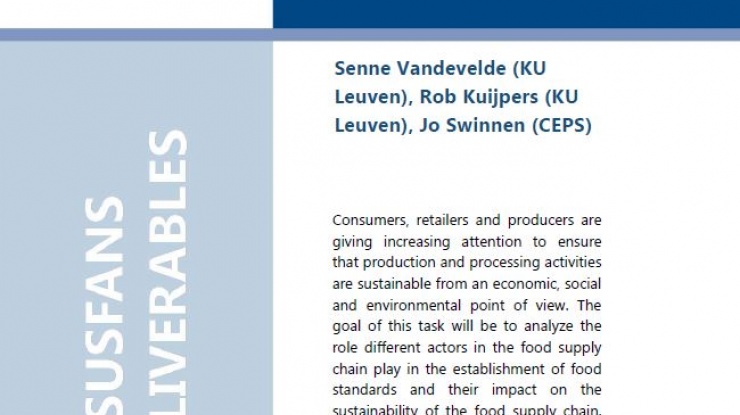
Deliverable 3.2: The role of different food chain actors on setting private food standards
Consumers, retailers and producers are giving increasing attention to ensure that production and processing activities are sustainable from an economic, social and environmental point of view. The goal of this task will be to analyze the role different actors in the food supply chain play in the establishment of food standards and their impact on the sustainability of the food supply chain. The analysis will consist of theoretical modelling and an empirical analysis.
Take a lookDeliverable 2.6: Simulations of diet recommendations and assessment of their economic, environmental and nutritional impacts.
We analyse ex-ante the sustainability effects of diet recommendations in France, Denmark and Finland to conclude that: 1- The promotion of several diet recommendations would improve social welfare; 2- Healthy-eating recommendations targeting consumption of fruits/vegetables, salt and saturated fat should be prioritized for promotion; 3- Although synergies dominate, trade-offs between environmental and health objectives occur in some cases ; and 4- The taste/utility cost of dietary change imposed on consumers should be included in the welfare analysis of diet recommendations.
Take a look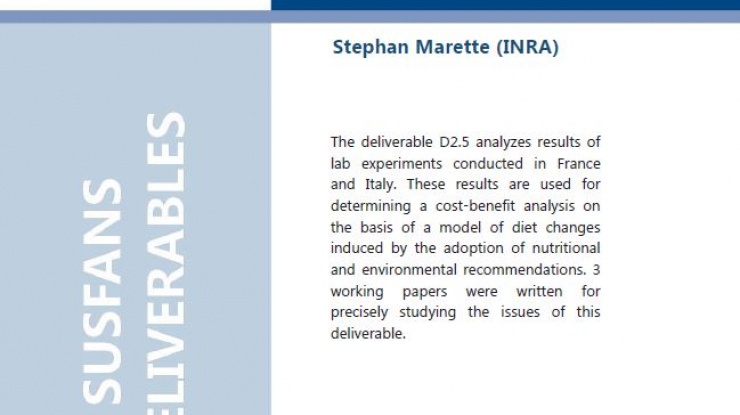
Deliverable 2.5: Consumer choice related to meat/fish consumption and their possible replacement by plant-based products: results from lab experiments and costbenefit analysis
The deliverable D2.5 analyzes the results of lab experiments conducted in France and Italy. We evaluate the impact of different types of information on participants’ willingness-to-pay (WTP) and quantity choices for both beef burger meat and soy burger meat. We conducted a lab experiment in France and Italy to elicit hypothetical WTP with a multiple-price list. Explanatory messages about the impact of beef and soy on health and environment were revealed to participants, before successive rounds of WTP determinations and quantity choices. Results show a very weak impact of successive rounds of messages on WTP for both beef and soy. However, these explanatory messages lead to a significant change in chosen quantities. These results are used for determining a cost-benefit analysis on the basis of a model of diet changes induced by the adoption of nutritional and environmental recommendations. We particularly show how both relative variations in willingness-to-pay (WTP) and relative variations in chosen quantities, following messages revealed in the lab, can be used for a welfare analysis. These variations are integrated in a market equilibrium model, as a possible demand shifter or as a non-internalized damage/benefit when consumers are ignorant. A related cost-benefit analysis studies the welfare impact of a nutritional recommendation or a tax mechanism. Results suggest that these regulatory tools have a significant impact on the variation of welfare and the reduction of beef consumption. 3 working papers provided in annex were written for precisely studying these issues of this deliverable.
Take a lookDeliverable 2.4: Preliminary report on Task 2.4: lab experiment on consumers choice
This deliverable presents the results of the first experiment conducted in France. The second experiment that will be conducted in Italy, and the cosbenefit analysis will be presented in the final version of the report, under the deliverable 2.5. The paper has been released to the consortium members.
Take a look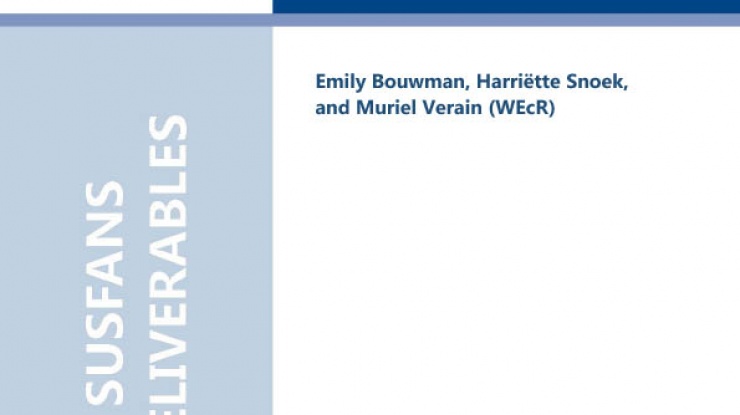
Deliverable 2.3: Analysis of the online choice experiment on fruit and vegetables determining the importance of nutritional and environmental benefits and the level of information
In this deliverable we investigate consumers’ sensitivity to product information on fruit and vegetable products. Fruit and vegetable consumption is associated with better health and prevention of diseases (Guillaumie et al., 2012) and more knowledge is needed on how product information on fruit and vegetable products influences consumer choices. This study contributes to the existing literature by studying the combination of health and sustainability information. In light of dual process theories (ELM; Petty & Cacioppo, 1986; HSM; Chaiken 1980) we took both message content and message characteristics into account.
Take a lookDeliverable 2.2: Protocol for defining the nutritional adequacy of total diets and foods consumed in EU countries
Protocol for defining the nutritional adequacy of total diets and foods consumed in EU countries
Take a lookDeliverable 2.1: Consumers’ knowledge about the determinants for a sustainable diet
The deliverable will report on Task 2.1. Drawing on the results of a web-survey, it will discuss the importance of incorporating national and regional habits into metrics and models for the SFNS diet.
Take a lookDeliverable 12.1 Consortium Agreement
Abstract: Strengthening food and nutrition security (FNS) in the EU requires a move towards a diet that supports sustainable food consumption and production. To gauge the policy reforms needed for this major societal challenge, the SUSFANS - consortium
Take a lookDeliverable 11: Communication Plan
This deliverable embodies the Communication Plan and will report on Task 11.1. The communication plan includes a long list of the future users of the SUSFANS toolbox and first clusters of regions and target groups.
Take a lookDeliverable 11.6: Feasibility and acceptance of SUSFANS Toolbox and results
Stakeholder workshops were held to increase awareness of the SUSFANS project outcomes and willingness to implement and consult the user toolbox in decision-making processes among stakeholders. Four workshops were held in France, Denmark, the Czech Republic, and Italy with in total 110 stakeholders from academia, national policy makers, industry, and NGO’s. We used a combination of general stakeholder workshops and specific group discussions with DEMOCs cards. Because of the complex and abstract structure of the SUSFANS toolboxes, the usability and feasibility outcomes were challenging for the stakeholders to discuss. Therefore, they were given future narratives of possible scenarios in the form of DEMOCS cards that helped workshops participants to come up with innovative ideas and propose further improvement, feasibility and acceptance of the SUSFANS toolboxes. Stakeholders appreciated the structured approach of SUSFANS to define sustainability in its four dimensions: environment, economics, cultural/social, nutrition/health. The SUSFANS visualizer was considered a useful tool to evaluate sustainability impacts of policies and support decision making of public policy makers in a more holistic and evidence based way. The toolbox was considered helpful to facilitate discussions between disciplines, countries, public and private on the health and sustainability outcomes, to have an informed discussion and get people to move. The abstract form of the toolboxes and the complexity, in combination with limited time to digest the provided information left participants with a challenge to foresee the exact application of the toolboxes in their daily practice.
Take a lookDeliverable 11.5: SUSFANS final outcomes workshop on pathways towards a sustainable and food and nutrition secure Europe WP11
In this document, a protocol is provided for the four workshops with stakeholders in the four countries: Denmark, Italy, France, and Czechia.
Take a lookDeliverable 11.3 - First leaflet and press release
This deliverable embodies the first leaflet and press release. Results from Task 11.3. Dissemination materials include: a) two project leaflets, b) press releases on the project in English and translated into the partners‘ languages, c) two articles for specific magazines and relevant audiences, d) an entity poster or roll-up stand featuring the logo and key messages of the contract for use at booths and workshops, and e) a yearly electronic newsletter
Take a lookDeliverable 11.2 Logo and Website
Abstract : This deliverable will report on Task 11.2. The project website, including the project logo and a SUSFANS community on LinkedIn, will have an external and internal structure. The website will offer completed research output as well as provide key data tha t will allow the user to interact with the research findings
Take a lookDeliverable 11 .1 Communication Plan
Abstract: This deliverable embodies the Communication Plan and will report on Task 11.1. The communication plan includes a long list of the future users of the SUSFANS toolbox and first clusters of regions and target groups
Take a lookDeliverable 10.4: Foresight of EU sustainable food and nutrition security: the interplay between major challenges and policy responses at different spatiotemporal scales
This deliverable reports on Task 10.4. Based on a quantification of a the combinations of future challenges and policies, it delivers summary challenges and efficient policy solutions for the EU sustainable FNS, stakeholder knowledge and priorities to ensure its suitability for decision
Take a lookDeliverable 10.3. The potential role of producer and consumer food policies in the EU to sustainable food and nutrition security
The aim of the research presented in SUSFANS D10.3 is threefold: (1) We identify a set of interesting and relevant policies in the areas of EU health and nutrition, agricultural, fisheries, and storage, i.e. market stabilisation, policies. (2) The SUSFANS modelling toolbox is applied. This gives the possibility to test and debug the most recent model developments following from previous SUSFANS work and identify further necessary improvements towards the end of the project. (3) We test the selected policy measures and assess their impacts on the EU agrofood system applying the SUSFANS metrics framework. Our results show, how the assessed policies may impact EU producers and consumers and how these can contribute to improving sustainability in the food system. Different established macro models are applied for the foresight analysis of the various policies. The policies tested are distinct from each other and are not run with all models available in the toolbox. In this sense, the presented research serves as a pre-test for the final foresight work in SUSFANS which will involve combined approaches of policies and models. Nevertheless, our results give already an insight on the directions of impacts as well as on the applicability and quantifiability of the metrics framework.
Take a lookDeliverable 10.2: Quantified future challenges to sustainable food and nutrition security in the EU
The aim of this paper is to provide a forward looking assessment of the baseline and alternative contextual scenarios in terms of their impacts on the sustainability of European Union's food and nutrition security. Our approach, on the one hand, allows to identify the future challenges and opportunities for the EU agro-food sector, and on the other hand provides a basis against which agro-food policies and innovations can be tested and evaluated in terms of their contribution to sustainable development.
Take a lookDeliverable 10.1: Quantified SUSFANS scenario drivers ready to be used by the modeling toolbox
This deliverable quantifies the most relevant scenario narratives spanning across the range of future challenges for the EU sustainable FNS for use in the SUSFANS toolbox.
Take a lookDeliverable 1.4: A modelling strategy for quantifying the sustainability of food and nutrition security in the EU
This deliverable outlines a modelling strategy for quantifying metrics and methods for quantifying the sustainability of EU FNS. SUSFANS models are assessed in terms of data needs, their limitations and the questions they can address related to sustainable FNS in the short term and the long term. This assessment sets the scene for operationalization of the SUSFANS Toolbox.
Take a lookDeliverable 1.3: Sustainability metrics for the EU food system: a review across economic, environmental and social considerations
One of the main objectives of the SUSFANS project is to develop a set of concepts and tools to help policy and decision makers across Europe make sense of the outcomes and trends of the EU food system. This paper proposes a set of metrics for assessing the performance of the EU food system in delivering sustainable food and nutrition security. The performance metrics have been built up through the aggregation of a wide range of variables, which together help to monitor the achievement of four overarching policy goals for the EU food system, namely a balanced diet for EU citizens, reduced environmental impacts, competitive agri-food businesses and equitable outcomes of the food system. The project decided to take a hierarchical approach to aggregating from Individual Variables to Derived Variables to Aggregate Indicators to Performance Metrics. This approach aims at marrying the notion that decision makers want only a small but powerful set of metrics to communicate the findings of the assessment, with the need to substantiate these metrics with the best available data from a large number of sources in a transparent way. In this deliverable the current set up of the performance metrics focus on each individual policy goal. In a related report, the team explores if and how the performance metrics presented here can be quantified using available data and modelling tools, and which of the models of the SUSFANS tool box can estimate which ones of the performance metrics and how (report D1.4). In a final step the SUSFANS team will bring all performance metrics together in an integrated set that will allow a view across all four policy goals and thus across all aspects of sustainable food and nutrition security (forthcoming report D1.5). Further work is the quantification of metrics using case studies and prospective scenario analysis. In addition to their use for monitoring, the proposed metrics are geared towards quantification using selected computational modelling tools. As such, SUSFANS aims to assist in foresight on and the evaluation of transformative changes in the food system with rigour and consistency.
Take a lookDeliverable 1.2: Metrics to assess Sustainable Food and Nutrition Security in the EU - a progress report
Metrics to assess Sustainable Food and Nutrition Security in the EU -a progress report. Released to consortium.
Take a lookDeliverable 1.1: A Framework for Assessing and Devising Policy for Sustainable Food and Nutrition Security in EU: The SUSFANS conceptual framework
This deliverable reports on Task D1.1., the development of a conceptual framework for the SUSFANS project. Drawing on a literature review and feedback from the SUSFANS stakeholder core group, the conceptual framework describes the actors of the EU food system, their activities, the food system outcomes and the factors directly and indirectly driving actor behaviour. The framework also shows the relationships between the food system and the key policy goals the EU has formulated for the system. The report highlights the benefitsof adopting a food systems approach to analysing EU sustainable food and nutrition security and ends with describing the use of the conceptual framework within the project and externally
Take a lookDefining a land boundary for sustainable livestock consumption
The need for more sustainable production and consumption of animal source food (ASF) is central to the achievement of the sustainable development goals: within this context, wise use of land is a core challenge and concern. A key question in feeding the future world is: how much ASF should we eat? We demonstrate that livestock raised under the circular economy concept could provide a significant, nonnegligible part (9–23 g/per capita) of our daily protein needs (~50–60 g/per capita). This livestock then would not consume human‐edible biomass, such as grains, but mainly convert leftovers from arable land and grass resources into valuable food, implying that production of livestock feed is largely decoupled from arable land. The availability of these biomass streams for livestock then determines the boundaries for livestock production and consumption. Under this concept, the competition for land for feed or food would be minimized and compared to no ASF, including some ASF in the human diet could free up about one quarter of global arable land. Our results also demonstrate that restricted growth in consumption of ASF in Africa and Asia would be feasible under these boundary conditions, while reductions in the rest of the world would be necessary to meet land use sustainability criteria. Managing this expansion and contraction of future consumption of ASF is essential for achieving sustainable nutrition security.
Take a look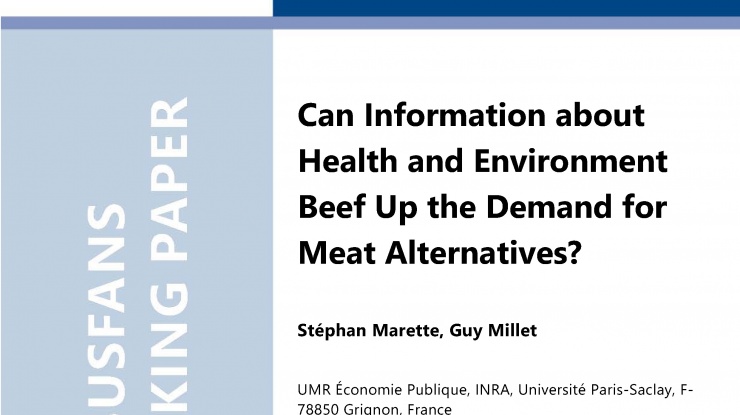
Can Information about Health and Environment Beef Up the Demand for Meat Alternatives?
A lab experiment was conducted in France to evaluate the impact of different types of information on participants’ willingness-to-pay (WTP) and quantity choices for both beef burger meat and soy burger meat. Explanatory messages about the impact of beef and oy on health and environment were revealed to participants, before successive rounds of WTP determinations and quantity choices. Results show that the different WTP for beef are not statistically influenced by the successive rounds of messages. Conversely, messages significantly increase the WTP for soy meat, even if this effect is relatively weak. These explanatory messages also lead to weak changes in the chosen quantities of beef and soy. A last round with the introduction of a high-quality beef leads to a statistically significant increase in the WTP for beef. Moreover, the selected quantities between beef and soy almost return to the initial quantities, namely the ones chosen before the revelation of messages. This reversal of chosen quantities towards more beef compared to soy underlines the participants’sensitivity to beef quality, when meat substitutes are considered.
Take a look